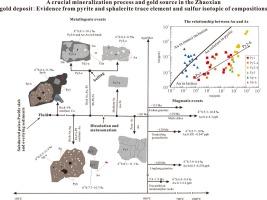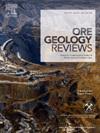中国胶东半岛招贤金矿床的关键成矿过程和金源:黄铁矿和闪锌矿痕量元素和硫同位素组成的证据
IF 3.2
2区 地球科学
Q1 GEOLOGY
引用次数: 0
摘要
招贤金矿床位于世界第三大、中国最大的金矿区,成矿深度1500-2200米,是揭示金源和成矿过程的理想研究对象。该研究通过岩石学、岩相学以及原位微量元素和硫同位素组成的综合分析,从不同的微观尺度提供了数值认识。该矿床呈现出不同的矿物沉淀序列,包括黄铁矿(Py1、Py2-a、Py2-b、Py3)和闪锌矿(Sp-a、Sp-b),具体如下:Py1 为正八面体至次正八面体,脆性断裂结构。Py2-a 大多为八面体,发育多孔质地,由黄铜矿、方铅矿和游离金填充。均质的 Py2-b 在 Py2-a 的边缘过度生长。Sp-a 呈多孔质地,主要由黄铜矿、Py3、方铅矿、游离金和银以及少量黄铁矿填充。均质的 Sp-b 生长在 Sp-a 的边缘,与磁铁矿共生。硫同位素分别为 Py1(0.1-11.1 ‰)、Py2-a(8.3-8.7 ‰)、Py2-b(9.1-10.1 ‰)、Py3(7.7-10.7 ‰)、Sp-a(9.5-11.4 ‰)和 Sp-b(8.4-9.3 ‰)和微量元素比值显示,成矿流体的来源具有一致性,与俯冲古太平洋板块和上覆沉积物以及岩石圈地幔密切相关,但在成矿的早期阶段也观察到小岩性地幔、前寒武纪岩石和中生代花岗岩的贡献。不过,成矿流体的含量在不同成矿阶段明显不同。值得注意的是,Py1 的砷含量(0.22-629.17 ppm)和金含量(0.01-0.20)较低,而 Py2-b 的砷含量(高达 12028.83 ppm)和金含量(0.59-4.61 ppm)最高。这些黄铁矿代中的金含量与砷和低熔点亲铝元素(LMCEs)的含量呈正相关,这意味着高含量的砷在金的迁移和沉淀中起着关键作用,而低含量的 LMCEs 也是不可或缺的因素。典型的多孔质地和元素分区表明流体沸腾并伴随着金的再移动,从而形成了黄铁矿中的高含量金或可见金。基于这些信息,我们建立了招贤金矿床的成矿过程模型。我们认为,对于胶东金的高含量而言,有效的迁移和沉淀机制比源区的初始富集更为关键。本文章由计算机程序翻译,如有差异,请以英文原文为准。

A crucial mineralization process and gold source in the Zhaoxian gold deposit, Jiaodong Peninsula, China: Evidence from pyrite and sphalerite trace element and sulfur isotopic compositions
The Zhaoxian gold deposit, located in the world’s third largest gold area and the largest in China, with a mineralization depth of 1500–2200 m, was the subject of ideal research to unravel gold source and mineralization process. Through comprehensive analyses incorporating petrology, petrography, and in-situ trace element and sulfur isotopic compositions, the study provides a numerical understanding from different microscales. The deposit exhibits distinct mineral precipitation sequences including pyrite (Py1, Py2-a, Py2-b, Py3) and sphalerite (Sp-a, Sp-b), detailed as follows: Py1 is euhedral to subhedral, brittle fracture structure. Py2-a is mostly euhedral and develop porous textures, filled by chalcopyrite, galena and free gold. The homogeneous Py2-b overgrows on the rims of Py2-a. Sp-a exhibits porous textures, filled with mainly chalcopyrite, Py3, galena, free gold and silver, and minor pyrrhotite. The homogeneous Sp-b overgrows on rims of Sp-a, coexisting with magnetite.
Sulfur isotope of Py1 (0.1–11.1 ‰), Py2-a (8.3–8.7 ‰), Py2-b (9.1–10.1 ‰), Py3(7.7–10.7 ‰), Sp-a (9.5–11.4 ‰) and Sp-b (8.4–9.3 ‰) and trace element ratios reveal consistency source of ore-forming fluids, closely associated with subducted paleo-Pacific slab and overlying sediments, as well as the lithospheric mantle, although contributions are also observed from the minor lithophoric mantle, Precambrian rocks, and Mesozoic granite during the early stage of mineralization. However, the contents of ore-forming fluids clear vary across different mineralization stages. Notably, Py1 has poor As (0.22–629.17 ppm) and Au (0.01–0.20), whereas Py2-b has the highest As (up to 12028.83 ppm) and Au (0.59–4.61 ppm). Gold contents in these pyrite generations correlates positively with the As and low-melting-point chalcophile-elements (LMCEs) contents, implying high contents of As play a critical role in Au migration and precipitation, and low contents of LMCEs are also an indispensable factor. Typical porous textures and elemental zoning indicate fluid boiling and accompanied by Au remobilization, resulting in the formation of the high contents of gold or visible gold in pyrite. Based on these information, a mineralization process model of the Zhaoxian gold deposit has been established. We figured that efficient migration and precipitation mechanisms are more crucial than the initial enrichment of source areas for the high contents of gold in Jiaodong.
求助全文
通过发布文献求助,成功后即可免费获取论文全文。
去求助
来源期刊

Ore Geology Reviews
地学-地质学
CiteScore
6.50
自引率
27.30%
发文量
546
审稿时长
22.9 weeks
期刊介绍:
Ore Geology Reviews aims to familiarize all earth scientists with recent advances in a number of interconnected disciplines related to the study of, and search for, ore deposits. The reviews range from brief to longer contributions, but the journal preferentially publishes manuscripts that fill the niche between the commonly shorter journal articles and the comprehensive book coverages, and thus has a special appeal to many authors and readers.
 求助内容:
求助内容: 应助结果提醒方式:
应助结果提醒方式:


